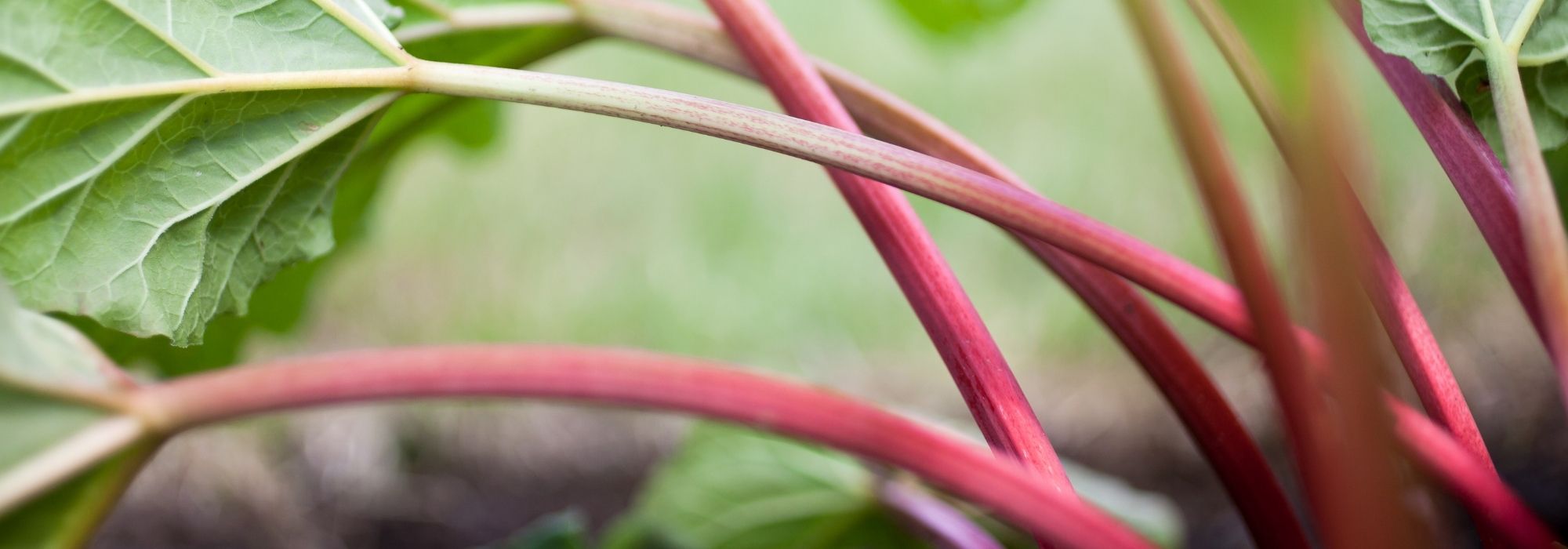
Rhubarb: planting, growing, harvest
Contents
Rhubarb in a nutshell
- Rhubarb is a hardy perennial vegetable grown for its edible stems
- Their tangy flavour is ideal for making numerous recipes; it is prepared cooked in jams, compotes…
- The peak season for harvesting rhubarb is in May-June
- It develops very large, highly ornamental but toxic leaves
- Very hardy, it is very easy to grow in cool, fertile soils
A word from our expert
Rhubarb is a hardy perennial vegetable plant grown and consumed for its stalks or petioles. Renowned for its tangy flavour, once peeled and cooked, it lends itself to numerous sweet or savoury recipes and is prepared in jams, compotes, tarts, or even chutneys to accompany meats. For rhubarb is a stem vegetable that is enjoyed like a fruit! Unlike its petioles, its leaves are inedible: they contain oxalic acid, which is highly toxic. However, this imposing foliage will add a very decorative touch to the vegetable garden or even to the ornamental garden.
There are two types of rhubarb: green (and green tinged with red) such as the ‘Giant Victoria’ Rhubarb and red varieties like the ‘Canada Red.’
Rhubarb is sown or planted in spring or autumn, with the first harvest occurring two years later: the harvest season generally begins in May.
In the garden, it thrives best in moist, fertile, rich soil, in full sun or partial shade: it is important to allocate sufficient space for its vigorous growth, as when happy, it can reach over 1.5 m in height when in flower, with an equal spread!
To grow it in the garden or vegetable patch, we invite you to discover the finest varieties of rhubarb in seed or young plant form, our tips for successful cultivation, and how to enjoy it!
Description and botany
Botanical data
- Latin name Rheum
- Family Polygonaceae
- Common name Rhubarb
- Flowering May-June
- Height 60 cm to 2 m
- Exposure Sun, Partial shade
- Soil type rich and cool
- Hardiness -15°C and above
Rhubarb (Rheum Rhaponticum, syn. rhabarbarum) is a perennial vegetable plant from the family Polygonaceae. Native to Asia, from the Russian Empire of the “barbarians”, in subtropical or temperate regions from Siberia to central China, up to 4000 meters in altitude, it has been cultivated there for 5000 years as a medicinal plant. It was introduced to Europe in the 18th century by Portuguese navigators. It is grown throughout France, mainly north of the Loire.
The genus includes about thirty species with green or red stems; regardless of the colour, the taste is similar. The most common is Rheum rhaponticum or garden rhubarb, which comes in various varieties such as ‘Victoria’ or ‘Canada Red’ with cherry-red stems.
Rhubarb is actually a stem vegetable cultivated for its fleshy petioles (the linear part that attaches the leaves to the rootstock): only its stems are edible.
This vigorous, rhizomatous plant anchors itself in the soil with a thick, fleshy taproot. It forms a large upright clump that can reach two meters wide and as high when in flower. A rhubarb plant can live for about ten years.
From this stump, long petioles, also called “midribs”, emerge in spring, measuring 30 to 40 cm, thick and 5 to 8 cm wide, which continue to grow until leafing. It is these fleshy midribs that are consumed once cooked. Their weight varies between 500 g and 1 kg. They have a very tart and sour flavour. The varieties of rhubarb with red stems offer a milder taste.
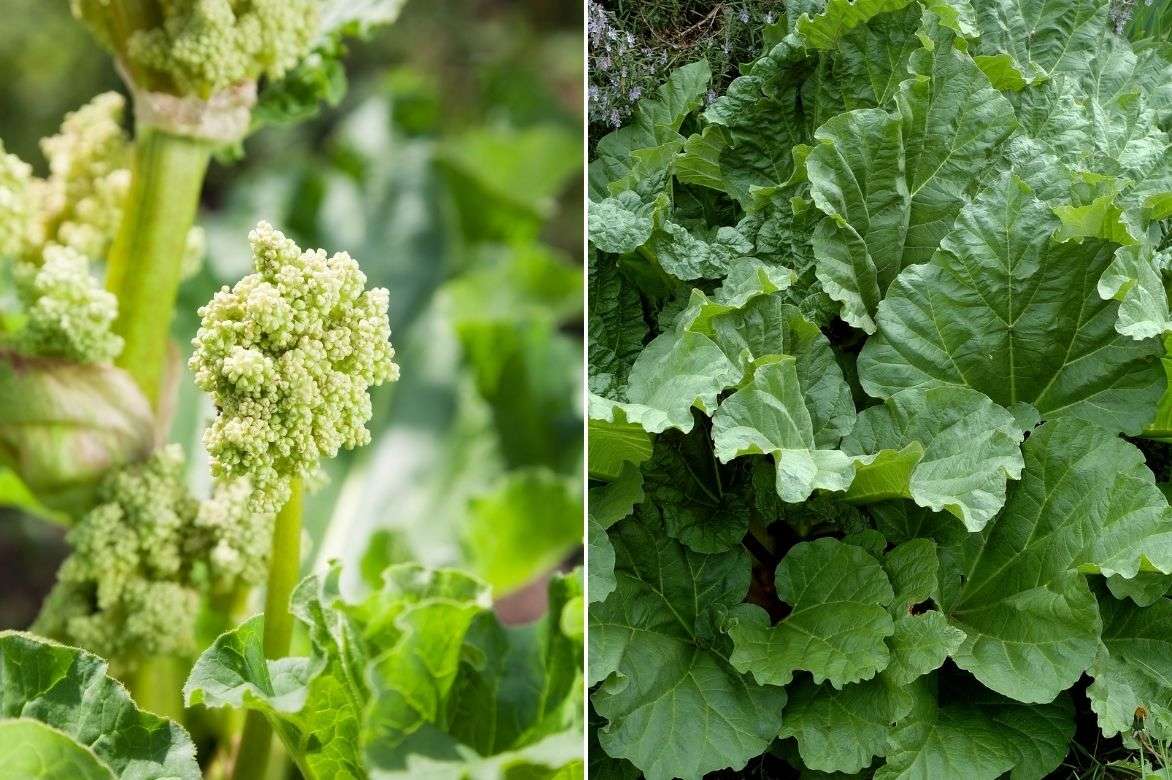
Rhubarb: flowering and foliage
The leaves, spectacular in size, measuring 30 to 70 cm in diameter, are thick and soft, heart-shaped, and heavily veined, composed of 5 lobes with undulating margins. This palmate foliage is inedible and deciduous. Medium to dark green, and more rarely red, it typically has a paler, rough underside with very prominent, villous veins. This very ample foliage is highly characteristic and ornamental. However, these leaves are toxic if ingested (in large quantities) as they are very high in oxalic acid, which can cause muscle spasms and kidney problems.
From June and throughout the summer, flowering emerges from this clump of large leaves, in the form of large panicles of tiny star-shaped flowers, gathered at the end of a long stem. Most often cream-white to greenish-white, they are particularly ornamental in certain varieties (Rheum palmatum ‘Atrosanguineum’ or ‘Tangiticum’), which display a sumptuous blood-red inflorescence.
At the end of summer, these flowers give way to small winged fruits filled with brown seeds. To encourage the production of stems, it is better to avoid allowing rhubarb to flower, as its seed production unnecessarily exhausts the plant.
“`
Read also
Sowing vegetable seedsMain species and varieties
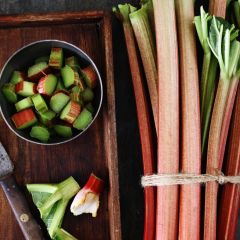
Rheum rhaponticum 'Victoria'
- Flowering time July to October
- Height at maturity 60 cm
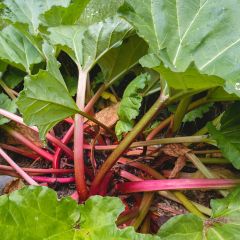
Rheum rhaponticum 'Paragon Rouge'
- Flowering time July to October
- Height at maturity 60 cm
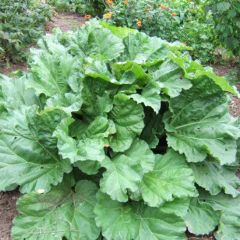
Giant Victoria Rhubarb Organic - Ferme de Sainte Marthe seeds
- Flowering time July
- Height at maturity 60 cm
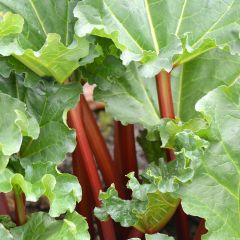
Canada Red Rhubarb
- Flowering time July
- Height at maturity 80 cm
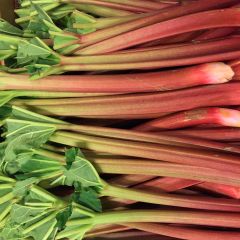
Organic Ribbed Rhubarb
- Flowering time July
- Height at maturity 1 m
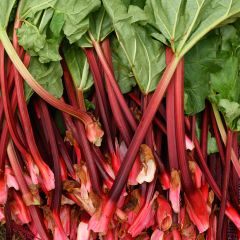
Fulton's Strawberry Surprise Rhubarb
- Flowering time July
- Height at maturity 60 cm
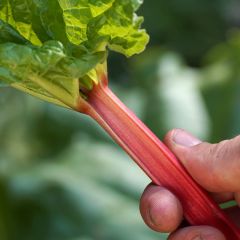
Glaskins Perpetual Organic Rhubarb - Ferme de Sainte Marthe seeds
- Flowering time July
- Height at maturity 60 cm
Discover other Rhubarb seeds
View all →Available in 1 sizes
Available in 1 sizes
Available in 1 sizes
Available in 1 sizes
Available in 1 sizes
Planting and sowing of rhubarb
Where to plant and sow it?
Rhubarb is very hardy and can withstand temperatures of around -15/-20°C. The plant disappears in winter and re-emerges in spring. It grows in all our regions, although it shows a clear preference for cool climates where it thrives best. Rhubarb requires rich soil, regularly amended with organic matter, deep, and remaining well cool to moist to prosper: it must never lack water. It is sensitive to overly calcareous soils. It enjoys full sun but also tolerates partial shade very well.
It takes up space! Reserve a location that matches its impressive growth (up to 1 m to 1.5 m in all directions at maturity) as it will tend to overshadow nearby vegetable plants: it is better to plant it isolated at the edge or in a corner of the vegetable garden. With its decorative foliage, it can blend into a perennial border, adding a lot of volume. Some smaller varieties can be grown in pots.
When and how to plant it?
Plant your rhubarb young plants in pots preferably in autumn in previously amended soil (3 to 4 kg of compost per m²), and well prepared. Maintain a distance of about 80 cm to 1 m at least in all directions between 2 plants so that the plant can develop well: 2 or 3 plants will be sufficient to meet a family’s needs.
- Loosen the soil deeply to 50 cm
- Add well-matured compost
- Dig a hole three times the volume of the root ball
- Place the root ball and fill in the planting hole
- Firm down well and water generously to aid establishment
- Mulch to keep the soil cool in summer
When and how to sow it?
Sowing rhubarb can be done in April-May or August-September, in pots or trays from seeds taken directly from your plant or chosen from our range: for a first harvest, you generally need to wait about 2 years after sowing.
- Sow a few seeds in a rich mix made up of a good seed compost improved with well-matured compost
- Keep the substrate moist but not waterlogged during germination, which takes between 10 and 30 days
- Thin to 25 cm
- When the plants reach the 4-5 leaf stage, transplant into individual pots
- Keep sheltered the first winter and plant out the following spring in March-April
Read also
Preserving garden fruitsGrowing and care
Rhubarb is not difficult to grow, but it is a greedy plant, requiring both water and organic matter. It will be generous as long as you provide it with compost every autumn. It prefers to have its roots cool: perform regular hoeing and spread a mulch around the base to maintain some moisture in the soil during summer. Water in case of prolonged drought or high temperatures.
Cut the flower stalks as soon as they appear to avoid unnecessarily exhausting the plant and to keep it vigorous.
Possible diseases
Vigorous, rhubarb can be susceptible to some fungal diseases such as rust, which leaves brown to orange pustules on the foliage. To prevent this: avoid wetting the leaves while watering. If affected: remove the diseased leaves and spray with horsetail or nettle manure on the foliage and discover our solutions to combat rust.
When the soil is moist, rhubarb leaves are prey to snails and slugs: discover our natural slug repellents and our 7 ways to fight effectively and naturally against slugs.
Multiplication
Rhubarb is propagated by sowing, but dividing clumps remains the simplest way to ensure its longevity. Practice on mature clumps that are 3 or 4 years old.
- In March or autumn, take pieces of the stump with 1 or 2 buds by slicing with a spade.
- Replant these pieces immediately in the garden in well-prepared soil, ensuring they are not buried too deeply.
- Firm the soil and water.
→ Learn more with Pascale’s tips in the tutorial: How to divide rhubarb?
Harvest and storage
- Harvest: petioles are harvested from May-June to September-October, as needed. Select firm stems. The harvest is done simply with a knife, cutting at the base of the stems. Be sure to leave about 1/3 of the stems on the plant.
- Storage: Rhubarb petioles only last a few days in the vegetable drawer of the refrigerator or a few months, washed and cut into sections, in a freezer bag placed in the freezer.
Culinary uses and nutritional benefits
Rhubarb is actually a vegetable that is cooked like a fruit. It is mainly consumed cooked after peeling. Before cooking your rhubarb stalks, cut off the ends, then peel them by pulling with a small knife to remove the skin, which comes off in strands. It can be made into jam, compote, marmalade, chutneys, in pies, cakes, crumbles, and can be served as a side dish with meat or fish. Its tangy flavour pairs perfectly with strawberry, banana, and apple, and is enhanced by spices like vanilla and cinnamon. It is also used for making beverages.
In ancient times, rhubarb was cultivated exclusively as a medicinal plant by the Chinese and Russians. It has recognised medicinal properties that have been valued for millennia. Rhubarb has aperitif, astringent, laxative, and refreshing qualities. Its stalks contain fibres, vitamins (B, C), and minerals (calcium, magnesium, iron).
Useful resources
- Our selection of 15 medicinal plants with numerous benefits… to grow in your garden
- Our tutorial: How to make rhubarb manure?
- In the kitchen with Ingrid for the rhubarb jam recipe!
- When and how to transplant rhubarb?
- Subscribe!
- Contents
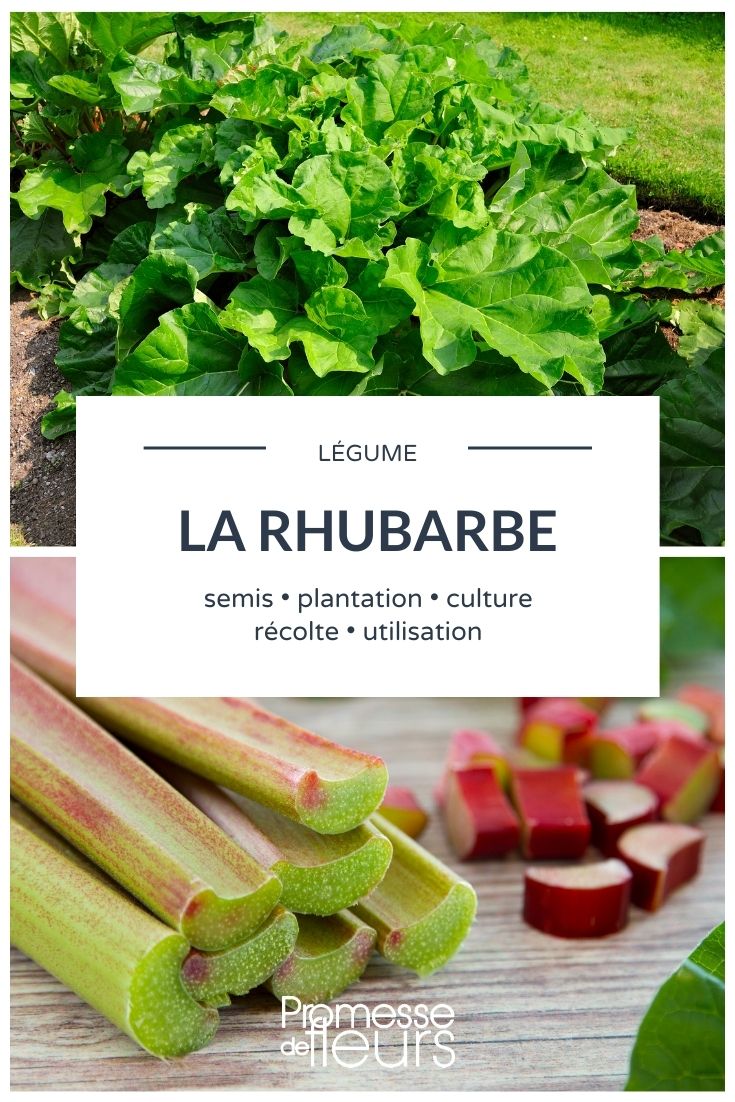































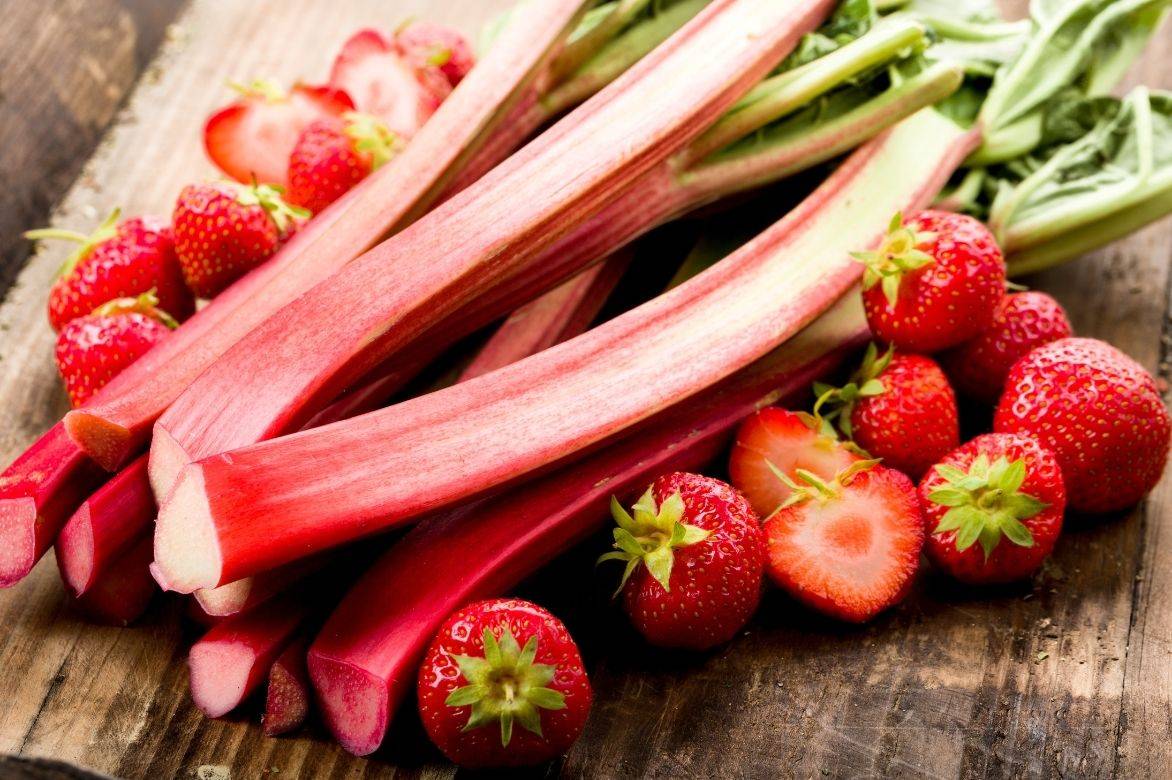


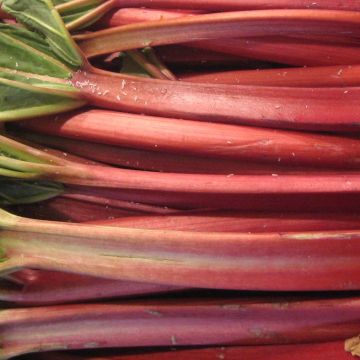


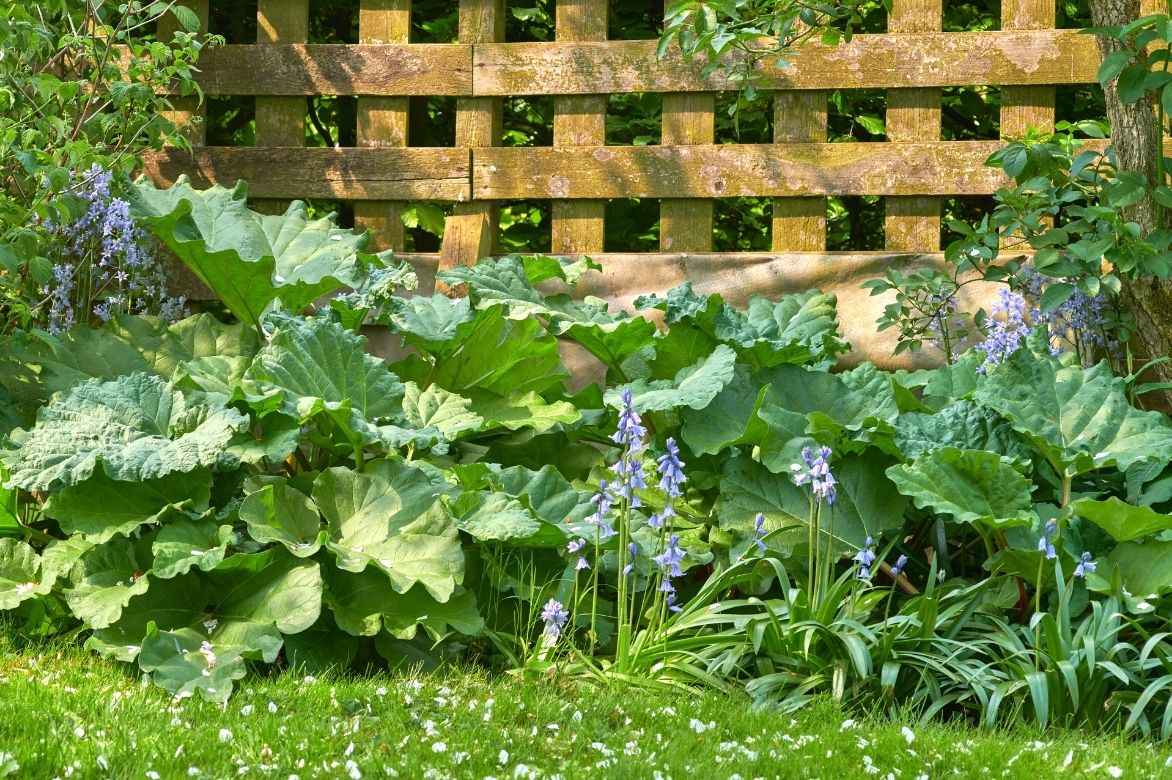
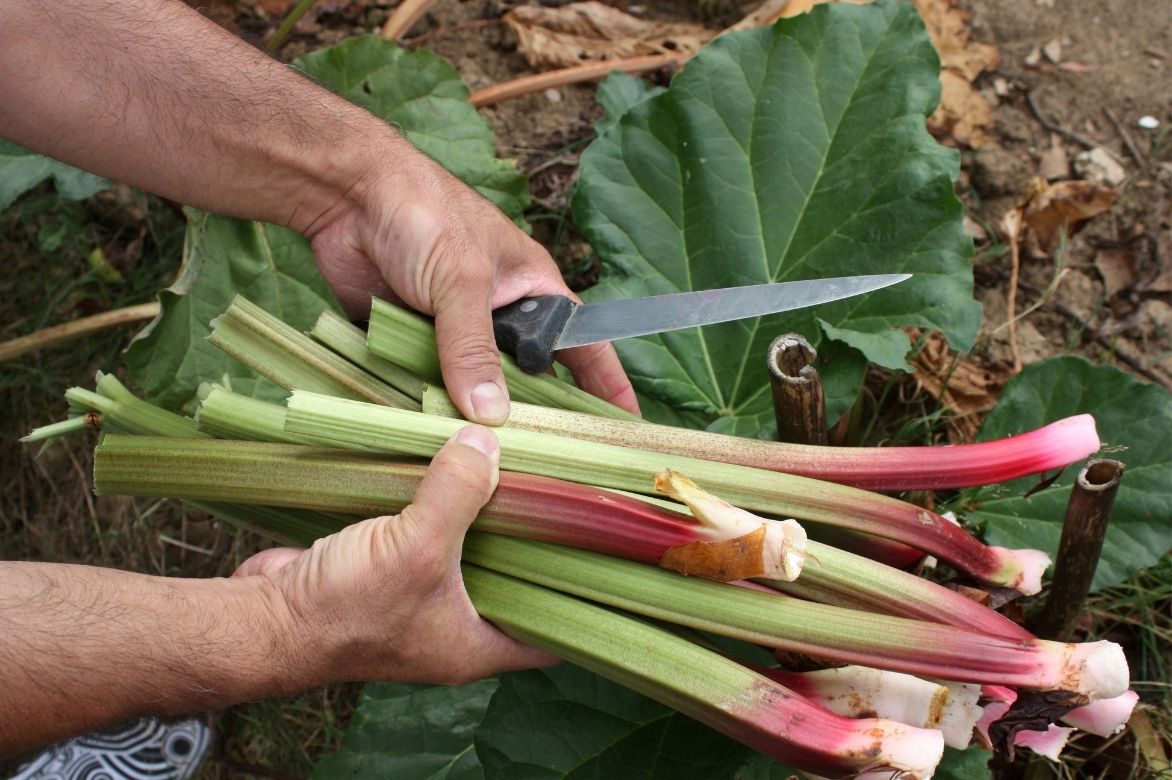
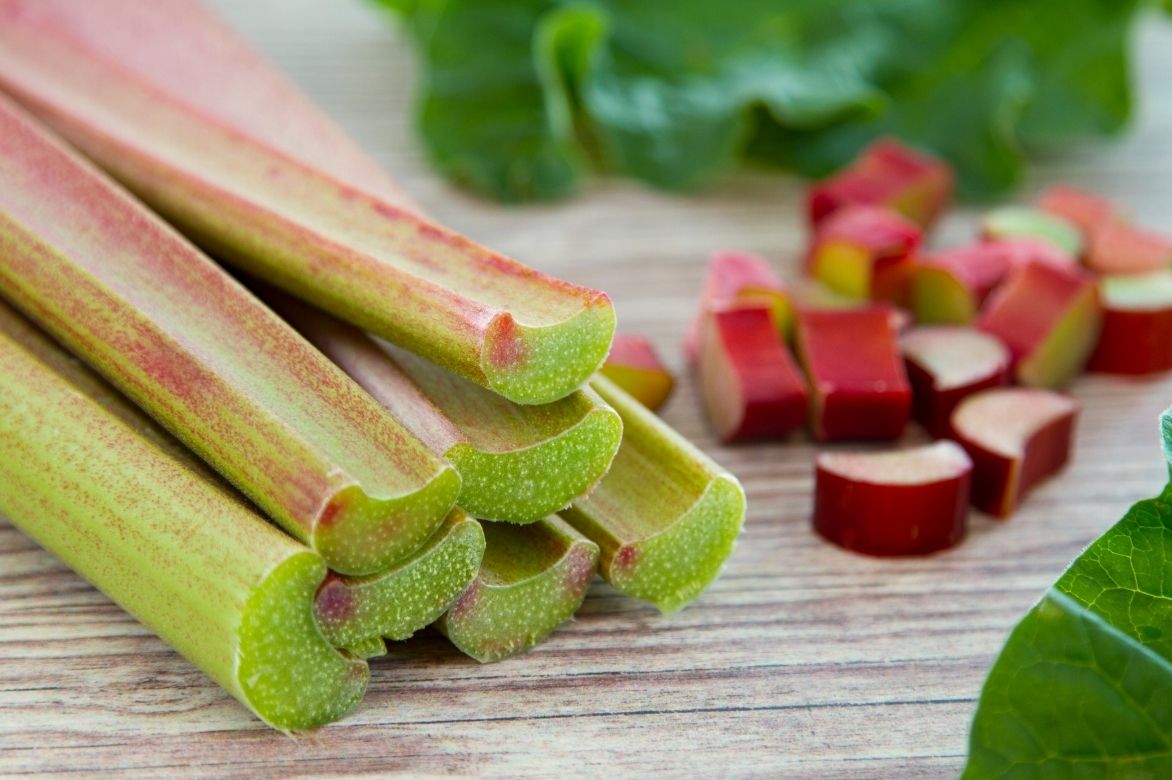
Comments